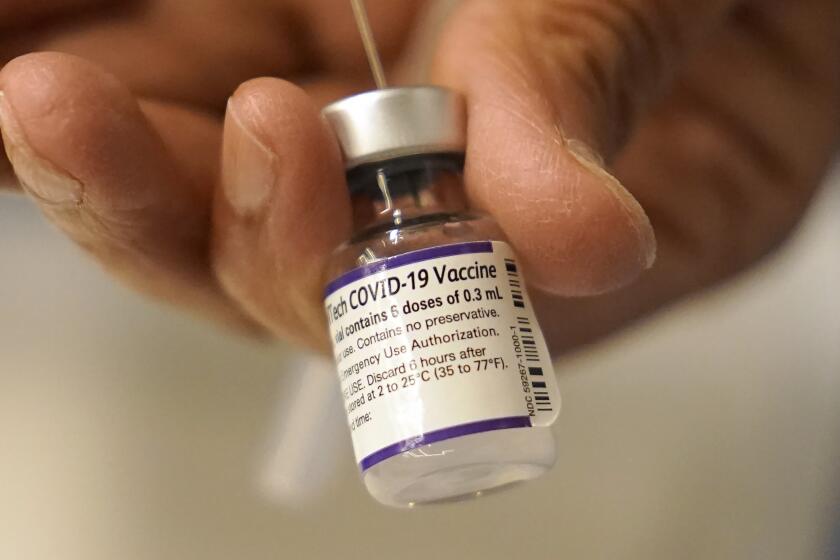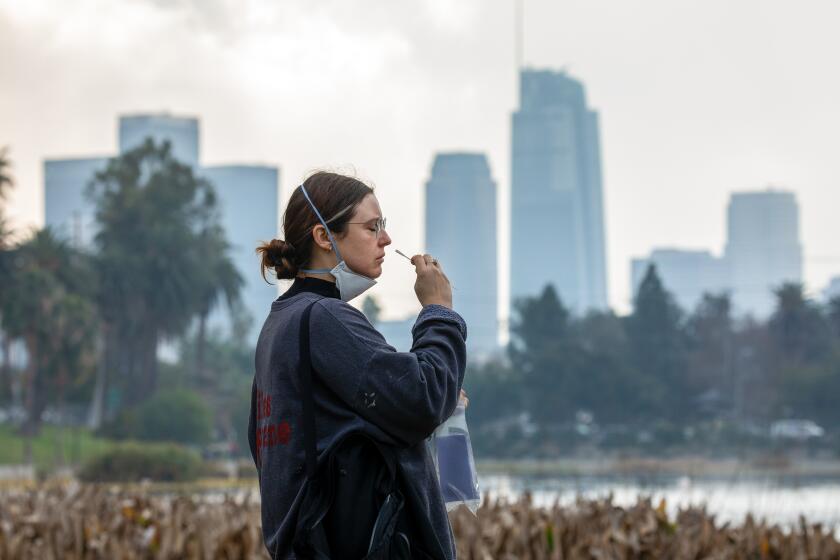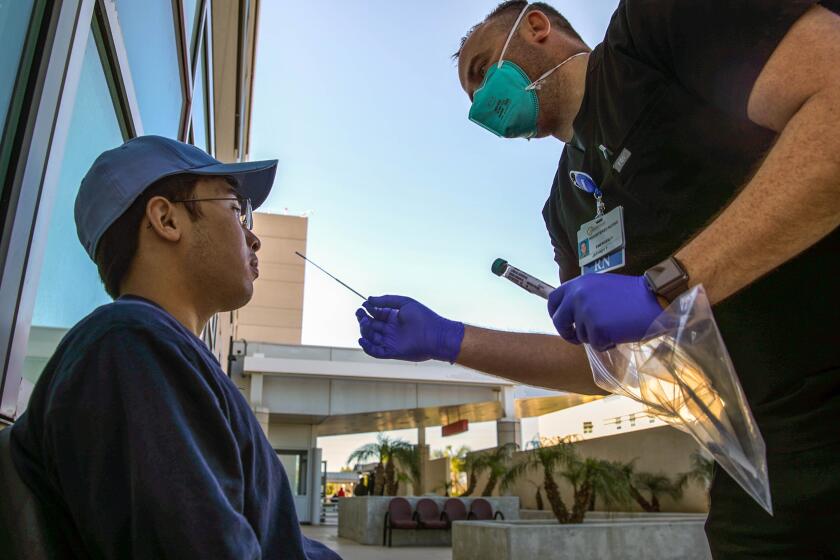California could see coronavirus increase this spring due to Omicron subvariant BA.2

Coronavirus cases are on the upswing worldwide, prompting some officials to warn that California could see increases this spring because of the Omicron subvariant BA.2, even though cases of the strain so far have been modest in the state.
The World Health Organization has recorded the first week-over-week increase in global coronavirus cases since late January, with cases rising 8% compared with the previous week. With infections up in parts of Africa, Asia and Europe, officials say they wouldnât be surprised if new cases climbed again in the U.S. â and in California â this spring.
What remains unclear is whether a national increase would be a ripple or a deluge that could again strain hospitals.
So far, coronavirus cases are either still declining or flat across California and in L.A. County.
What accounts for BA.2âs recent success? Itâs not due to an ability to evade the protection of COVID-19 vaccines, a new study finds.
But even with the decline, officials are closely watching how Omicron subvariant BA.2 â which is 30% to 60% more contagious than the original Omicron variant â constitutes a growing percentage of new cases.
Nationally, BA.2 represented an estimated 23% of variants analyzed between March 6 and March 12, according to the U.S. Centers for Disease Control and Prevention. The previous week, the subvariant represented an estimated 14% of virus cases analyzed nationally. BA.2 was found most frequently in the Northeast, where it represented nearly 40% of coronavirus cases; on the West Coast, it represented about 25% of cases.
Scripps Research Translational Institute microbiologist Kristian Andersen projected on Twitter last week that in San Diego County, almost all new coronavirus infections will be of the BA.2 subvariant in the near future.
The growth of BA.2 has been more mixed elsewhere. In L.A. County, BA.2 accounted for 6.4% of coronavirus specimens analyzed between Feb. 20 and Feb. 26, the most recent data available; a week earlier, it was 5%, according to Public Health Director Barbara Ferrer.
In Northern Californiaâs most populous county, Santa Clara County, most of the Omicron cases being detected in the Palo Alto area are of the BA.2 subvariant, but that gets less prevalent farther south, such as in Gilroy.
âInterestingly â and this gives me hope â it is not driving up the levels overall. I donât know why, but it isnât,â Dr. Sara Cody, the Santa Clara County public health director and health officer, said last week. âBut weâre watching that very, very carefully.â
âDeltacronâ is a hybrid of Delta and Omicron. How worried should California be?
Thereâs no certainty that L.A. County will experience the kind of BA.2 surges that many European countries are seeing now, Ferrer said, but it remains quite possible it could become a dominant strain.
BA.2 is probably not the only reason other countries are seeing sharp increases in coronavirus cases, she added; the jumps come as many public health measures that limited coronavirus transmission have been rescinded and as protection from vaccinations and booster shots have waned over time.
Itâs essential that more be done to get more people vaccinated and boosted, especially those who are vulnerable, Ferrer said. She expressed alarm about the lack of action to continue federal funding of vaccination, testing and treatment efforts for uninsured residents.
Ferrer said that because of the stalemate in Washington, many of L.A. Countyâs community groups no longer will be reimbursed for the vaccination or testing of uninsured people as of Tuesday, a situation that âwrecks our network immediately.â
âMy hope is that, swiftly, our federal elected officials are going to work together with the White House to get a package passed,â Ferrer said. âWe need to be prepared for a potential challenge in the future â and in the near future. We donât want to be caught off guard; we need to have supply chains in place; we need people to have [personal protective equipment].â
The coronavirus variant known as BA.2, or the âstealth Omicron,â now causes more than a third of new Omicron infections around the world.
Cody echoed Ferrerâs statements, warning that âCOVID funding has essentially collapsed. That is breathtaking and shocking in the middle of a global pandemic.â
Myoung Cha, chief strategy officer at San Francisco-based Carbon Health and former head of strategic initiatives at Apple Health, warned in a series of tweets Saturday that the âBA.2 cycle has already started here and will be in full bloomâ in about two to three weeks, âwith a much bigger surge than anyone saw coming.â
Potential signs of worry stem from the U.S. having lower vaccination and booster rates than Europe, less testing and a longer period of waning immunity. Cha suggested that BA.2 cases would peak in the Northeast first, but predicting trends in the U.S. could be hampered by at-home rapid tests, whose results are not reported to the government, as opposed to lab-based PCR tests, which are reported to officials.
Cha noted that Google search trends for cold symptoms âseem to be on the rise right now.â
âThe irony is that eagerness to go back to normal and the lifting of social distancing measures will accelerate the surge beyond what otherwise would have been,â Cha wrote. âFor many people, going back to pre-COVID behaviors may seem fine and the actual risk from BA.2 may be low. What is at stake is the impact on immunocompromised and older adults who will be disproportionately affected by another surge along with our healthcare system.â
Dr. Eric Topol, director of the Scripps institute, echoed Chaâs concerns. âRight now weâre mainly relying on hope as our defense, when it ought to be boosting at scale,â Topol tweeted.
Topol expressed worry that there are millions of vaccinated American seniors who are well overdue for getting their booster shot.
In New York City, an increase in coronavirus cases may have already begun.
Itâs important to note, however, that BA.2 hasnât had the same effect on all countries. It has become dominant in Bangladesh, India and South Africa, yet none of those countries has seen the kind of overall jump in case rates that Britain, Germany, Austria and Switzerland have had, according to data shared by Topol.
Itâs also possible that the U.S. could see a milder effect from BA.2 than Europe or Asia, according to Andy Slavitt, a former senior advisor on COVID-19 with the Biden administration.
In a series of tweets Sunday, Slavitt said itâs worth noting that the U.S. version of Omicron that dominated the nation this winter was actually more contagious than the version that hit Europe earlier. The version that hit Europe was BA.1, and the U.S. subvariant was its descendant, BA.1.1.
In other words, a nastier Omicron winter for the U.S. compared with Europe could spell a less severe spring of BA.2, according to Slavittâs reasoning.
âIf this sounds too optimistic for some, itâs still too pessimistic for others,â Slavitt wrote. âIf you donât want to count on luck, get vaccinated and boosted, wear masks when cases rise near you and take care with people with higher risk factors.â
California has identified a number of cases of BA.2, a sublineage of the Omicron variant. How concerned should we be?
California health officials continue to strongly recommend universal mask wearing in indoor public settings.
According to Ferrer, there have been only a handful of documented cases in which someone infected with an earlier Omicron subvariant was reinfected with BA.2.
âBut itâs early in the research cycle on this,â Ferrer said. âShould we start seeing a lot more BA.2 circulating, we all need to take additional precautions, particularly if we are at high risk,â and urge those unvaccinated or who havenât received their boosters to âtake this opportunity [to get their shots] before BA.2 starts circulating more widely.â
Dr. Anthony Fauci, the U.S. governmentâs top infectious-disease expert, said in a televised interview last week that he would not be surprised if the U.S. sees an increase in cases in coming weeks.
And although some experts have noted that hospitalizations have started to rise in parts of Europe, Fauci said Britain has not yet detected heavier demand among intensive care units, ânor are they seeing any increase in all-cause mortality.â
Dr. Ashish Jha, the incoming White House COVID-19 response coordinator, said in broadcast interviews last week that heâs not expecting a big surge in the U.S. from BA.2, but said there could be a small one.
Pfizer and BioNTech have requested authorization for a second booster shot for seniors, and Moderna went a step further and asked permission for a second booster shot for all adults.
The CDC already recommends that those 12 and older with moderate or severely compromised immune systems who have had three doses of vaccinations of the Pfizer or Moderna shots get a fourth dose. For immune-compromised people who got the Johnson & Johnson vaccination as their primary inoculation and have already received a second dose of vaccine, officials recommend an additional shot, for a total of three doses.
California is recording a coronavirus case rate of about 60 to 70 cases a week for every 100,000 residents. L.A. Countyâs rates have hovered between 74 and 115 this month â a range not seen since the beginning of December, just before the Omicron surge began rapidly growing, and a tiny fraction of the countyâs peak rate of more than 3,000 in early January.
The latest levels are tantalizingly close to a goal of fewer than 50 cases a week for every 100,000 residents, a level at which coronavirus transmission is seen as moderate and no longer substantial.
More to Read
Sign up for Essential California
The most important California stories and recommendations in your inbox every morning.
You may occasionally receive promotional content from the Los Angeles Times.
















